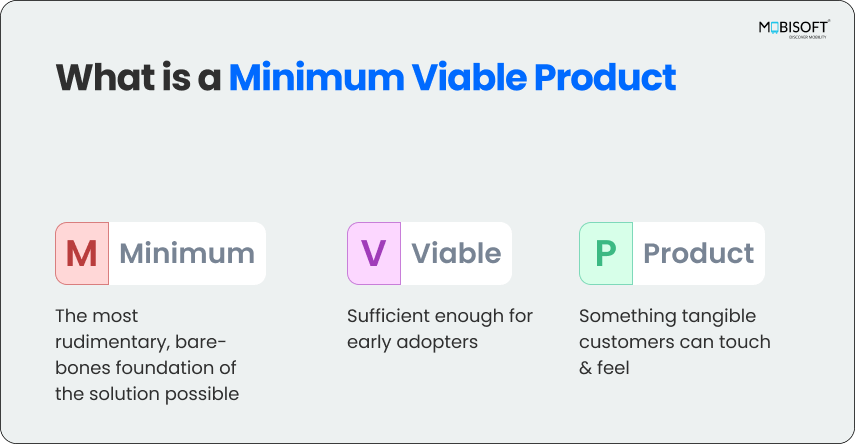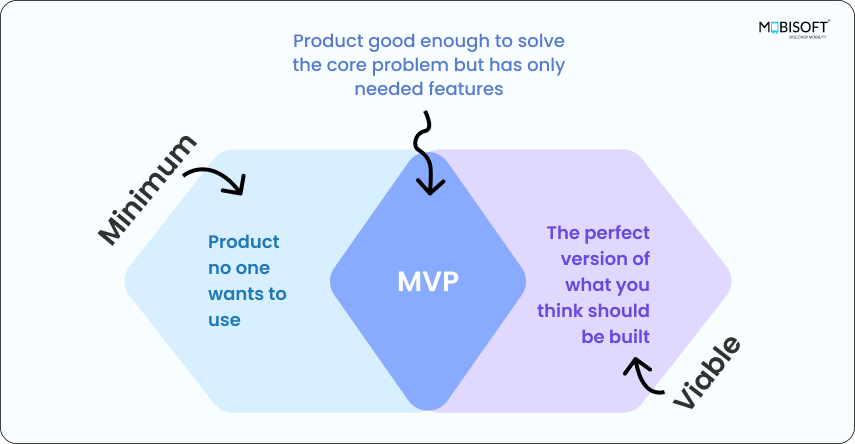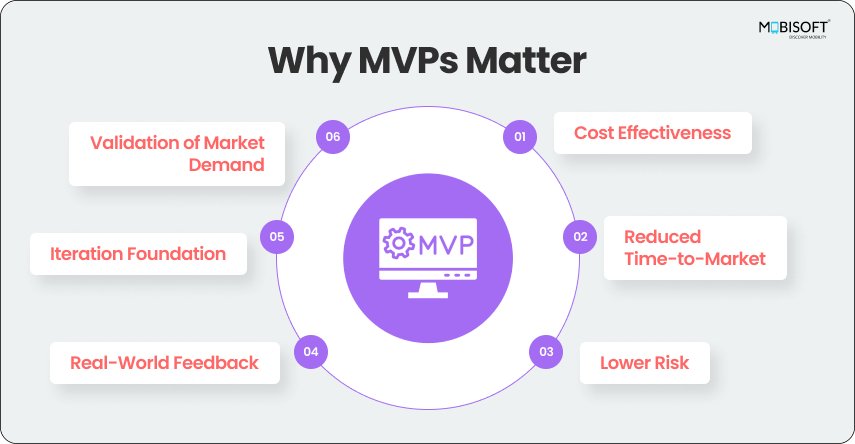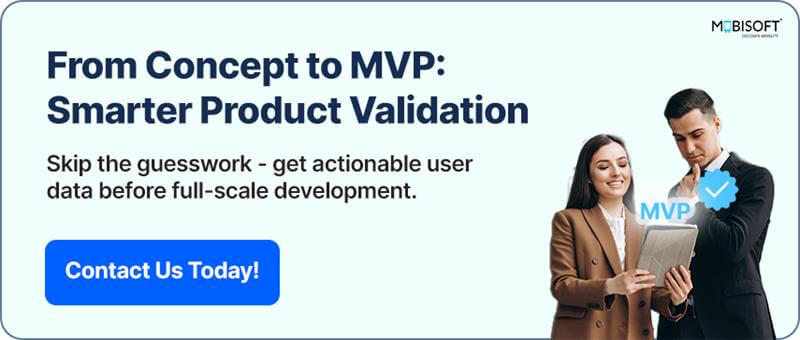In today’s fast-paced business world, MVP product design & development is a high-stakes game. You’re expected to innovate, create value, and grab customer attention before your coffee gets cold.
Whether you’re a startup building an MVP or an established company aiming to stay ahead, the question is the same: How do you test new ideas without draining your budget or flying blind?
That’s where the Minimum Viable Product (MVP) comes in. Think of it as a smarter way to experiment without betting the whole farm. The MVP is one of the sharpest tools in any innovator’s toolkit. But what exactly is it? Why does it matter? And who needs to use it?
Let’s break it down. We’ll look at what a minimum viable product is, where the idea came from, and why this approach can make or break your next big launch.
Understanding the Minimum Viable Product (MVP) in Product Development

At its core, a Minimum Viable Product (MVP) is a product with just enough features to deliver value to early users and collect feedback for future development. You build only what’s necessary to validate your core assumptions. It’s not about delivering a half-baked product but about delivering a focused one.
- Minimum means the smallest set of features needed to start learning.
- Viable means the product is usable enough to attract early adopters.
- Product means you’re not shipping vaporware. You’re offering something real.
The MVP in product management isn’t your final product. It’s a stepping stone. A learning tool. A way to answer this essential question early: “Do people even want this?”
MVP = Only essential features + Maximum learning with minimum effort
To achieve this efficiently, many companies rely on a trusted Custom Software Development Company to architect robust MVPs that are both scalable and user-focused.

Origins of the MVP Concept in Lean Startup Methodology
Frank Robinson originally coined the term minimum viable product in 2001, and there was no second thought that it would be the 'must-see' concept for Software Development companies, startups, and even enterprise organizations.
As time passed, the term MVP expanded with the emergence of the Lean Startup methodology and was also made popular by Eric Ries in his book The Lean Startup, released in 2011.
Lean Startup is a framework employed to create and operate successful startups by focusing on creating products that address real market issues without wasting time and resources on untested assumptions.
The Lean Startup method revolves around three core ideas:
- Build something small that tests your main hypothesis.
- Measure how real users interact with it.
- Learn from the results and decide whether to improve, pivot, or pause.
The MVP concept emerged in this context as one of the principal components of this approach. The idea is that MVP startups should iterate on product hypotheses in the early stages with limited resources. By focusing on learning and not on perfection, founders can avoid the usual pitfall of spending too much time and money on something that doesn't take off with their target segment.
For enterprise innovation cohorts, big companies also value MVPs as a method for introducing new products or services with minimal risk of capital loss. MVPs enable them to test new ideas on a small scale, validate ideas, and get educated in advance before they decide to scale the project.
Why Do MVPs Matter in Product Strategy?

The Minimum Viable Product matters to companies of all sizes. It addresses multiple problems that all product teams, startup founders, and MVP product management professionals encounter:
1. Cost Effectiveness
Developing a feature-rich product can be costly. The MVP method saves companies money by prioritizing the key features that address the essential problem for customers. A CB Insights report reveals that 42% of startups fail because there is no market need for their product. An MVP reduces this risk by validating the product's core value proposition before heavy investment in development.
2. Reduced Time-to-Market
One of the biggest advantages of MVP is that it allows a company to bring its product to market quickly. Time is money, especially in this fast-paced business world. The sooner you pilot your concept, receive feedback, and iterate, the quicker you can create something that truly appeals to your clientele. A McKinsey & Company study revealed that companies that prioritize speed in MVP product development are 1.5 times more likely to experience revenue growth.
3. Lower Risk
Building a product based on assumptions can lead to huge losses, particularly if the product does not meet the requirements of the market. An MVP allows companies to test ideas with less capital and reduce the risk of failure. By getting real users to use your product or service early, you can find out where the potential problems are before they become more costly issues. In a study by Statista, 14% of startup founders attribute “no market need” as the reason for failure. With an MVP, that can be reduced by quick and efficient testing.
4. Real-World Feedback
An MVP is a learning tool. The real value of an MVP is in how it enables businesses to collect data and feedback from actual users, who provide input that developers, product managers, or entrepreneurs may never think of. It's about validating hypotheses in the real world and iterating on the actual pain points of customers. MVP product teams that utilize feedback loops for iteration by customer demand are capable of seeing up to 40% increased product-market fit and customer satisfaction, observes Harvard Business Review.
5. Iteration Foundation
After the initial release of an MVP is complete, the product team is prepared to iterate based on customer feedback. Unlike the waterfall approach, where everything is decided before actual development occurs, the MVP allows for continuous improvement. A revealing statistic from Harvard Business Review is that businesses that implement iterative MVP development processes achieve 4x growth versus businesses implementing more traditional practices.
Let's make it essential to explore resources like MVP Development: The Ultimate Guide to Selecting the Right Tech Stack to choose the right tools from the start.
6. Validation of Market Demand
The MVP helps businesses know if there is a market for what they are producing before investing heavily in it. According to Forbes, 42% of startups fail because they inaccurately estimate the market demand for their products. MVPs allow you to test the waters, validate your assumptions, and pivot if necessary, reducing the risk of failure.
Who Should Use an MVP? Target Roles & Companies

The MVP model isn’t just for startup founders. It’s a critical strategy for a wide range of organizations looking to develop new products.
1. Startups
Startups are the primary beneficiaries of the MVP approach. They typically have limited resources and need to test their concept quickly on a shoestring. An MVP enables them to bring a product to the market rapidly, gather data, and craft their products before scaling up.
2. Enterprises & Corporate Innovation Teams
Business enterprise organizations have a different set of challenges to face: scaling innovation, selling diverse groups of stakeholders on it, and reducing risk in new programs. For these companies, MVPs are an inexpensive way to pilot new offerings or enter new markets. MVPs enable innovation teams to validate concepts in real-world settings without spending massive amounts of resources upfront by collaborating with expert IT solutions services providers.
3. Product Managers
For product managers, an MVP is a structured way to test hypotheses and MVP product-market fit without wasting time on unnecessary features. They can then bet intelligently and make data-driven decisions to make the product incrementally better in the long run.
4. Investors
For investors, an MVP is a product that proves whether a product has potential before investing heavily in it. It reduces the risk of investing in a product that will not have demand or user interest.

Real-World Minimum Viable Product Examples of MVP Startups That Scaled Globally
Following are some powerful minimum viable product examples of companies that went from Simple MVP to Global Giant by implementing the MVP development strategy to achieve success.
Airbnb (Hospitality)
Airbnb, now one of the world's most lucrative online hospitality sites, started as a humble idea to offer individuals temporary housing. The founders, Joe Gebbia and Brian Chesky, however, did not start a large-scale development project right away. They built a very bare-bones MVP to test the viability of the idea.
MVP Approach:
As a test of the concept, the Airbnb team listed their apartment with photos on a website. They did not make a sophisticated platform first. Rather, they used a basic platform with one listing only. They rented out air mattresses in their apartment and posted photos of their apartment available for rent for a large San Francisco event. They received their first guests, which was the final validation they needed that people were willing to pay to spend a night in private homes.
Impact:
This low-key MVP allowed the founders to test their idea with a very low initial investment. Their early success with this low version validated the model of renting rooms in people's homes. This minimum viable product example and its feedback helped them scale, and they grew Airbnb into a multi-billion-dollar company. Today, Airbnb is worth over $100 billion.
Instacart (eCommerce/Quick-Commerce)
Instacart, founded by Apoorva Mehta in 2012, is a grocery pick-up and delivery service that partners with major retailers like Costco, Safeway, and Kroger to have groceries delivered at consumers' doorsteps. Instacart's idea came into existence due to the restriction on online grocery shopping in the United States, as consumers were struggling to buy fresh food and staples online and get them delivered quickly.
MVP Approach:
Instacart's MVP development process was a simple, manual system. Instead of building a complete app and logistics infrastructure, Instacart began with a simple website to allow customers to order groceries. But the actual fulfillment work was manual. Instacart employees would go to local stores, retrieve the groceries themselves, and drop them off at customers' doors. This type of lean startup MVP was initially a trial to validate demand in the grocery delivery space.
Impact:
Instacart's MVP was a huge hit immediately, and consumers enjoyed the quality and convenience of the service. The manual approach helped the company gather important data on customer behavior, logistical issues, and market demand without making big investments upfront. Instacart was one of the leaders in the U.S. grocery delivery market within a matter of years. The company had a valuation of $39 billion in 2021, and it serves millions of customers across North America.
Pager (Health tech)
Pager is a health tech startup with the vision of delivering on-demand health services on a mobile platform without intermediaries or communication bottlenecks between patients and providers. The co-founders, a former hospital executive and a physician, saw an opportunity to address inefficiencies in the healthcare industry by making it easier for patients and providers to talk to each other through digital platforms.
MVP Approach:
Pager's MVP was a basic mobile app that joined patients and doctors via text message or phone. Instead of building a multi-feature, full-featured health care platform, Pager's initial iteration focused on allowing instant access to a hand-picked subset of services, such as responding to patients' health questions or connecting customers with on-demand physicians. They pinpointed high-priority domains like simplicity of use, convenience, speed, and gaining medical care.
Impact:
Pager's MVP gained traction, particularly in urban areas where people were looking for convenient, accessible health advice and care. Input gained through the initial users allowed the company to refine the app's features and make decisions on additional services to add, including prescriptions or home care. Pager continued to expand and grow and is now integrated into various health systems and offers services such as telemedicine along with home health visits. Pager has accrued more than $100 million in funding and keeps growing in the telemedicine space.
Dropbox (Software, Cloud storage)
Dropbox, founded by Drew Houston and Arash Ferdowsi, started as an answer to a small problem: the hassle of carrying around USB drives or dealing with unreliable email attachments. Before fully embarking on product development, Dropbox initially needed to determine that there was, in fact, demand for a cloud file storage product.
MVP Approach:
Instead of building the entire product in advance, Dropbox released a video MVP. A showreel of the product's core features, such as syncing files across devices. The video demonstrated how Dropbox would allow people to store, upload, and access files with any internet-connected device. Showcasing the power of intuitive interfaces often built with expert Mobile App UI Design Services.
Impact:
The video created tremendous visibility, including among early adopters and investors. The feedback confirmed a true demand for the product, allowing Dropbox to start development. The MVP allowed Dropbox to secure $1.2 million in seed funding and have a customer base before spending on wide-scale development. Dropbox is today a world cloud storage giant with more than 700 million users and a market capitalization of more than $8 billion.
These MVP examples from hospitality, eCommerce/quick-commerce, healthcare, and cloud storage illustrate how the MVP approach can be applied effectively across various industries. Whether it was augmenting hospitality services with Airbnb, facilitating grocery shopping with Instacart, connecting patients and physicians through a mobile app MVP with Pager, or synchronizing data with cloud-based MVP Development Services on-demand with Dropbox - each organization used a lean, iterative approach to pilot their ideas initially before scaling them into global phenomena. Today, that has led to massive growth when the underlying value proposition strikes a chord with customers in the truest sense.
In Summary
The Minimum Viable Product (MVP) is a practical approach to building and launching products. It helps reduce risk, cut unnecessary costs, and learn what users want. Instead of waiting for the perfect version, you build a simple product with just the core features - the essence of MVP product design - and put it in front of real users. That early feedback gives you clarity on what to improve and where to go next.
Whether you’re a startup developing an MVP for a new product, an enterprise exploring new market opportunities, or a product manager focused on MVP strategy and testing, the MVP method gives you a smarter way to move forward. In today’s fast-paced market, learning fast beats building slow. And with an MVP, you're doing exactly that - learning, adapting, and growing with purpose through MVP development best practices.





 March 6, 2025
March 6, 2025


